 Photo
Photo (popular souvenir from
Scotland of Nessie).
Gerald McSorley, 67, from Stirling, made the find as he walked along the
shores of the loch, north of Drumnadrochit in the Scottish Highlands. The find
was recognized by scientists in the National Museum in Edinburgh to be the
remains of a 150-million-year-old adult plesiosaur (referred from the Scotsman's
website 16 July 2003).
The creature was characterised by a long-necked, carnivorous sea reptile,
submerged in shallow water on the banks of the loch. The 35-foot-long creature
thrived in the world's seas about 155 million years ago, during the Jurassic and
Cretaceous periods. The well-preserved 12-inch long fossil clearly shows four
vertebrae, with spinal chord and blood vessels set in grey limestone. This
matches well with "observations" in recent time of the sea monster reptile in
Loch Ness.
However, the museum experts believe the find is not related to Nessie, as
Loch Ness was formed relatively recently towards the end of the last Ice Age -
about 15,000 years ago. Therefore the legend about the snake-like Nessie still
goes on. Would we ever see proof about the existence of Nessie?
Stein Morten Lund, 19 July 2003
Additional information:
Read more about Nessie and Scotland on our website.
Here you can also
read about other similar creatures around the world (Norway, China, Australia
etc).
BIG NEWS FROM AUSTRALIA:
"Nessie" found in
Australia - Remains of a 120-million-year-old plesiosaur, which looks like
Scotland's Loch Ness Monster, has been discovered in the central Australian
outback. So perhaps Nessie in Scotland has a relative in Australia?
(READ MORE HERE)
For further information about Nessie:
www.news.scotsman.com and www.scotsman.com
